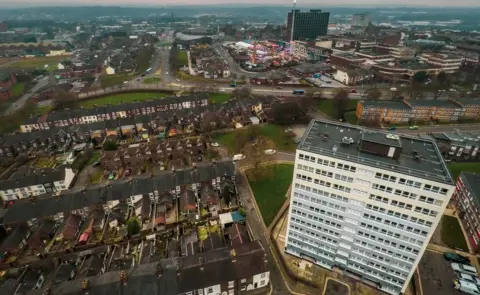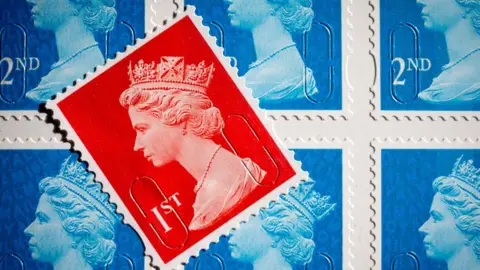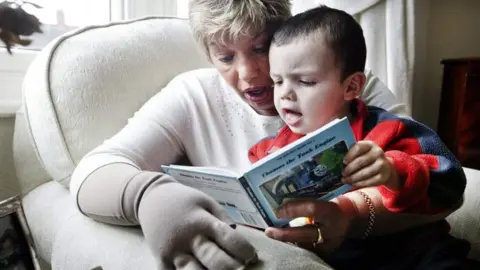We are Stoke-on-Trent: The Stokies who made their mark
 Getty Images
Getty ImagesSix towns make up the city of Stoke-on-Trent, famous for oatcakes, calling strangers "duck" and, of course, its global reputation for ceramics and pottery.
The BBC's We Are Stoke-on-Trent project is shining a light on The Potteries and its stories. And whether you realise it or not, the people of this city will no doubt have touched your life in some way.
So what have Stokies - as they are commonly known - given the world?
Britain's most famous war-plane
 Getty Images
Getty ImagesMore than 20,000 Spitfires were built for the Royal Air Force following its unveiling in 1938 - and 19,000 of those were used during World War Two.
The British icon was a formidable killing machine, combining speed, manoeuvrability and firepower and the planes helped RAF pilots gun down almost 2,000 German Luftwaffe fighters during the Battle of Britain.
Its designer was Reginald Joseph 'RJ' Mitchell, born and raised in Stoke-on-Trent. He died in 1938 before he could see his design's wartime achievements but reportedly said he thought Spitfire was a "bloody silly name" for it.
The majority of the war planes were made at a plant in Castle Bromwich, which at its peak was sending 320 of them off the production line each month.
Although no longer in production, the aircraft is as much loved today as ever. In August, a newly-restored Spitfire took off from Goodwood aerodrome in West Sussex for a round-the-world trip.
200 billion portraits of the Queen
 Getty Images
Getty ImagesThe birthday card you received from your grandparents this year probably had a corner of Stoke-on-Trent on it.
It is estimated the portrait of Queen Elizabeth II seen on stamps has been printed in excess of 200 billion times, reportedly making it the most reproduced image in history.
The artist behind it was Arnold Machin - the son of a potter and a potter himself, who was born in Stoke-on-Trent in 1911.
Unchanged since 1967, it has been his effigy of the Queen - a relief sculpture made in clay - that has been stuck in the top right corner of letters tumbling through post boxes around the world.
The design is "instantly recognisable and an icon of the British monarchy", according to the Postal Museum.
Access to a breast cancer 'wonder drug'
 Rob Irving
Rob IrvingBefore 2010, women in the early stages of breast cancer would not have had access to a treatment shown to have remarkable life-prolonging qualities.
The woman who changed that was Dorothy 'Dot' Griffiths, from Stoke-on-Trent, who campaigned for Herceptin to be made freely available to patients in England, before her death that year.
She was initially denied access to the drug, which works by limiting the growth of cancer cells and then encouraging the immune system to kill them.
"She'd never taken anything out of the NHS," said Dot's son, Rob Irving. "But when she needed it, the NHS said no. She saw it as deeply unfair.
"[The NHS] was going to let people die needlessly and she wasn't prepared to let that happen."
Dot was given 18 months to live after her diagnosis in 2000, but survived for 10 years. In that decade - and despite being extremely ill herself - she campaigned relentlessly for wider access to Herceptin so others could get the drug.
Mr Irving said he still sometimes got messages from patients wishing to say thank you to his mum. He said he had received messages saying, "if it wasn't for your mum, I'd be dead".
It was not until 2018 the National Institute for Health and Care Excellence recommended the drug be used in the early stages of treating breast cancer - before that it was reserved for advanced stage treatment.
A knight with a golden boot
 PA Media
PA MediaFootballing legend Sir Stanley Matthews started and ended his 33-year career with Stoke City FC.
Born on Seymour Street in Hanley in 1915, he joined the club - nicknamed The Potters - at the age of 15 and returned as "the Wizard of Dribble" on the same pitch at the age of 50, after a 14-year stint with Blackpool.
In 1956, he was the inaugural winner of the Ballon d'Or - then known as the European Footballer of the Year award - and the following year was appointed CBE, the first time a professional footballer was recognised by the Queen.
In another first, he was the only professional footballer to be knighted while still playing the game. In 1965, at the age of 50, the son of a barber became Sir Stanley.
He made nearly 700 League appearances for Stoke City and Blackpool as well as 84 England caps and was never booked or sent off.
After his death in 2000, his ashes were buried beneath the centre circle at Stoke City's stadium.
Tiling the corridors of power
 House of Lords/Roger Harris
House of Lords/Roger HarrisEvery day, Stoke-on-Trent is under the feet of some of the world's most powerful politicians.
In 1834, ceramics company Minton - founded in the city in 1793 - was commissioned to tile the Houses of Parliament, along with designer Augustus Pugin.
It became one of the most recognisable names in tiling and was in 1856 requested to tile the Capitol building in the United States - home to Congress and the Senate.
The flooring was replaced in the 1970s by the successor company to Minton, while the tiles in Westminster are available to buy for £200 each.
 Getty Images
Getty ImagesYou'll also find the company's tiles in Melbourne's State Parliament of Victoria, Washington DC's National Portrait Gallery, the Victoria and Albert Museum in London, and countless Victorian terraced houses from Staffordshire to the Midlands.
Ceramics and potters have shaped the history of Stoke-on-Trent for centuries, turning out brands which have become household names, such as Wedgwood, Royal Doulton and Emma Bridgewater.
The city is often nicknamed The Potteries and to this day is still famous for its home-grown talent.
Your car radio (and your car, and your radio)
 Official Windows Magazine
Official Windows MagazineMaybe Stoke-on-Trent didn't invent the car itself, but if you drove to work this morning you have a Stokie to thank for the fact that your engine started.
What's more, you have the same Stokie to thank for the tunes that got you started too.
Oliver Lodge, born in 1851, was a celebrated physicist who - among other things - developed radio and also invented the spark plug - the device which starts car engines.
Even if you drive an electric car, a little piece of Stoke-on-Trent is still helping you get moving as ceramics are used in car batteries to increase battery life.
In 1894, he became the first person to transmit a message in Morse code using a wireless signal - something Mr Lodge was reportedly never convinced would be that useful.
By the 1920s radio had become much more akin to what we would recognise today, with the inventor even becoming a popular BBC broadcaster himself.
This article was created as part of We are Stoke-on-Trent, a BBC project with the people of the city to tell us the stories which matter to them.

Get in touch
What are you proud of about the city and what are the stories you think we should tell more people about?
Have you got a question about Stoke-on-Trent you would like us to answer? You can use the tool below to submit your suggestions.
If you are reading this page on the BBC News app, you will need to visit the mobile version of the BBC News Website to submit your question on this topic.
For more information about We Are Stoke-on-Trent follow #BBCWeAreStokeonTrent on social media. You can also email us [email protected]
